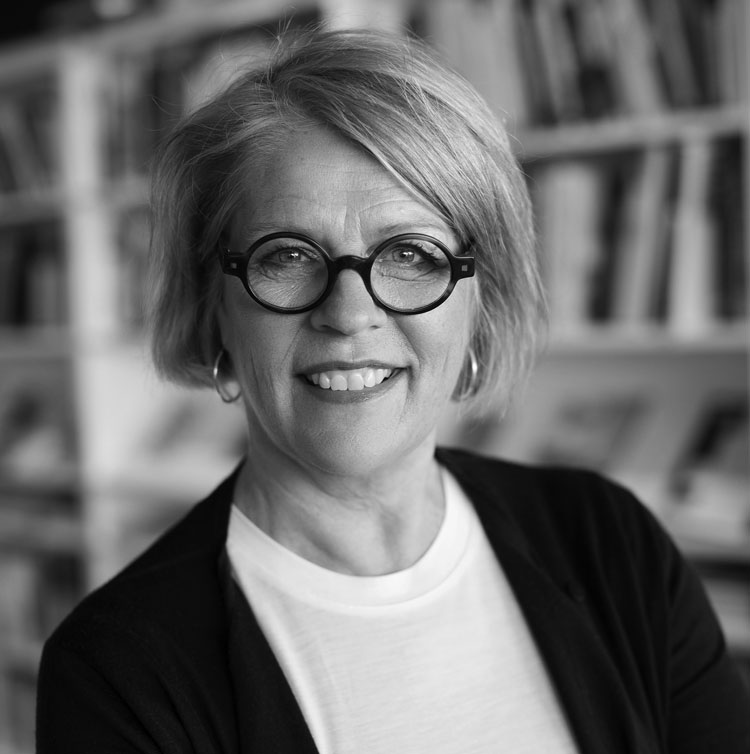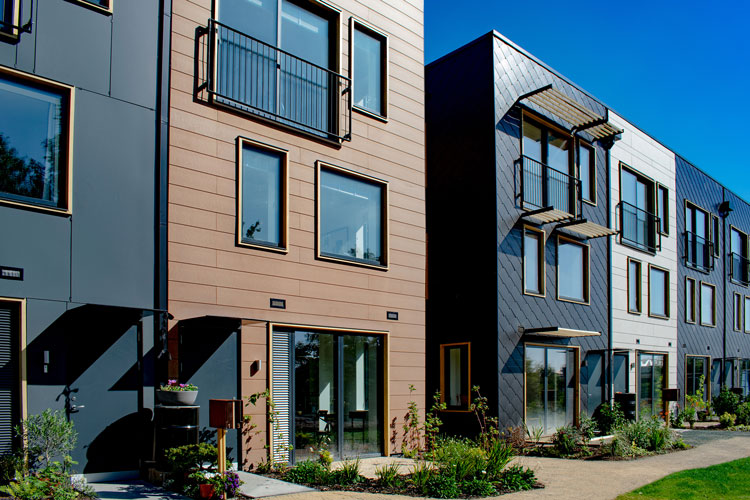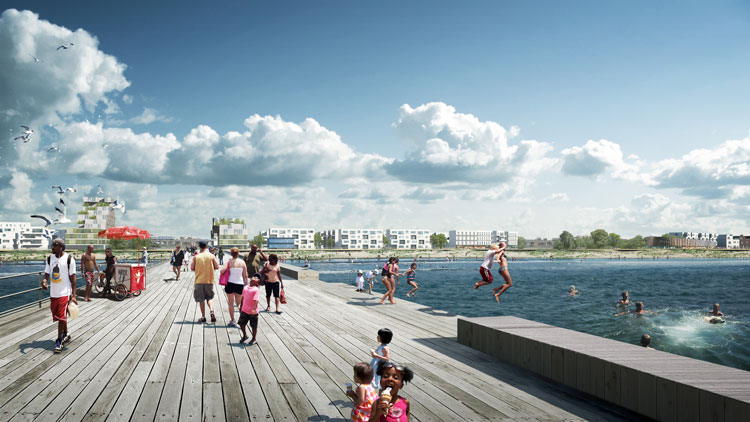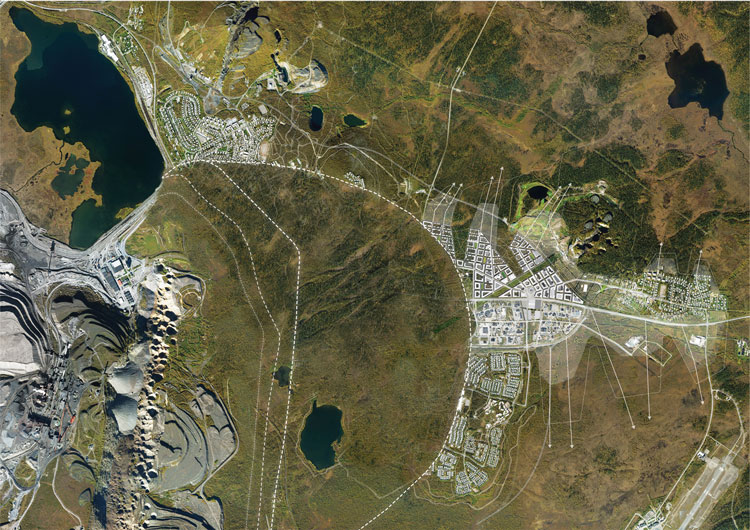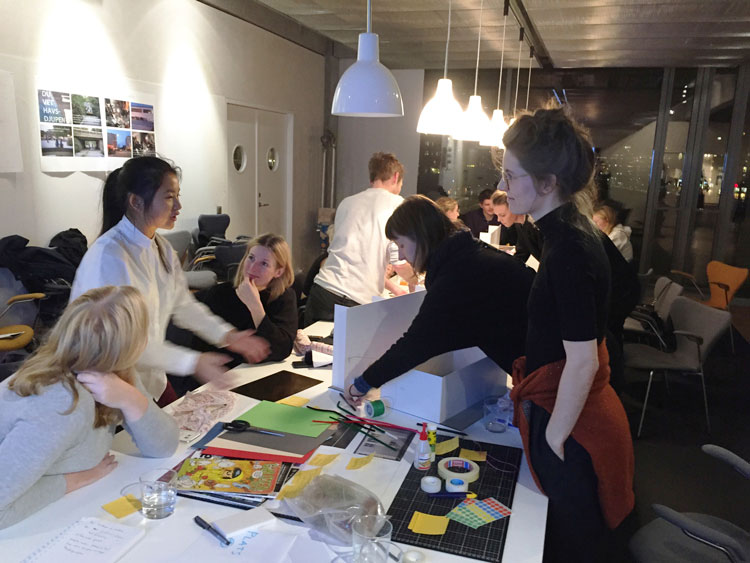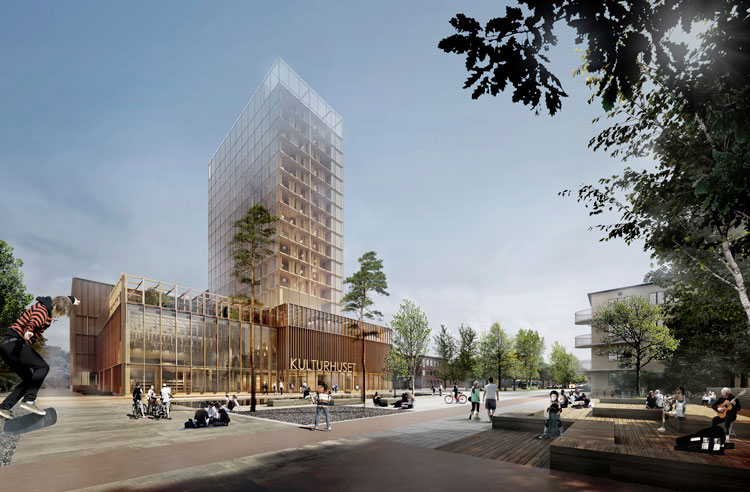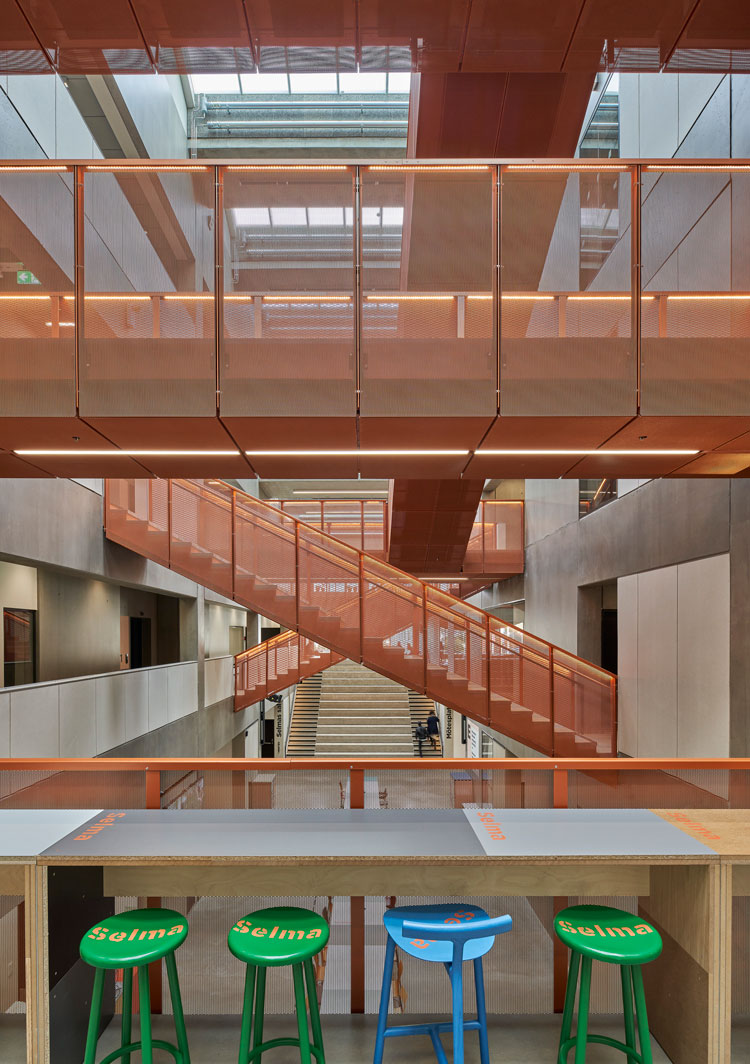

by NICOLA HOMER
Monica von Schmalensee has run one of the largest architectural practices in Scandinavia, White Arkitekter, where she is a senior partner, and has served as a strategic adviser for the Swedish government as deputy national architect and president at the Council of Sustainable Cities. Since its foundation in the 1950s, White Arkitekter has designed buildings with environmental sustainability in mind. This can be seen in its cultural centre in Skellefteå, Sweden, and its masterplan for the relocation of the country’s northernmost town, Kiruna. The practice was part of the delegation from the Swedish government to the UN climate change conference in Paris in 2015. It was recently named as the only company to join the Sweden Local 2030 Hub, a UN hub for the 2030 Agenda for Sustainable Development – an initiative with 17 goals that aims to leave no one behind. Von Schmalensee is also a design advocate for the mayor of London, the only one to be based outside the capital. With her interest in sustainability, she is ideally placed to talk about how design can address climate change and the effects of the global pandemic on the future of cities.
[image10]
Nicola Homer: I am talking with you as a writer for Studio International, which incorporates the Studio, an illustrated magazine of fine and applied art that was first published in 1893, at the time of the Arts and Crafts movement. In the spirit of internationalism, can I ask you to tell me a little bit about design history in Sweden, for example with regard to the Stockholm exhibition in 1930 of the Arts and Crafts home industries?
Monica von Schmalensee: Yes, it’s very interesting that you mention that. To be able to look into the future, we always need to go back to our history. The Arts and Crafts movement was part of the Industrial Revolution. In the 19th century and the early 20th century, Stockholm was overpopulated, with bad living conditions, which meant that it was a divided city. There were a lot of diseases, not just the Spanish flu. With its emphasis on daylight and open-air planning, the exhibition in Stockholm was an answer to the living conditions of the previous years. It was influenced by the Garden Cities and the Arts and Crafts movements, to see how the home needed to be changed to become healthier. The Bauhaus movement was also influential on the show. The exhibition itself was a great success, as there were a lot of visitors. The intention was to create a new model for the working class and the middle class, but it kind of stopped there.
[image5]
At the same time, there was an evolution in living conditions. Architects were influenced by developments in the 30s, but it was not until the 40s and 50s that things really changed. It was at this time that the Swedish model, which was about improving living conditions, really made progress. That was a great moment. “The Swedish model” became a nickname for the social democrats, bringing improvements to healthcare and education. People moved into the cities. In the 60s, we had the Million Homes Programme of housing development, to meet a need for 1m residences. Architects and planners visited the country at this time, because they were interested in the pioneering example that Sweden was setting. For instance, Vällingby was inaugurated in 1954, following the concept of the “ABC town” – where “A” was for work, “B” was for residential and “C” was for commercial functions – and it became one of the most renowned suburbs of Stockholm. The inspiration behind it was the concept of the English new town and it was designed by [the modernist architect] Sven Markelius, as part of the plan for Stockholm at that time. It created a great model where you could live and work that is still relevant today. In 1958, Ikea was founded in the spirit that ordinary people could furnish a home with beautiful furniture. That moment held great interest for architects and planners, and society as a whole. This captures the zeitgeist in which the practice of White Arkitekter was founded.
[image2]
NH: I understand that this moment brought ideas of modernism into the public realm that maybe improved everyday standards of living.
MS: Absolutely, yes.
NH: Now, I’d like to move forwards to the 50s, when White Arkitekter was founded by the British architect Sidney White with partners. I understand that you served as a chief executive at the practice between 2010 and 2017 and continue to be a senior partner. Could you tell me a bit about the story of the practice, from the 50s to the present day?
MS: Yes. In 1951, White, together with four other architects, who worked in the spirit of social democracy, won a competition to design housing in a town called Örebro. It seems very modern today because it was about how to create three-storey housing with well-designed apartments, in which you could stand in the kitchen and look into the bathroom. At the same time, you could look out through the window and see children playing outside on the playground. It was around that central point that those kinds of neighbourhoods were created. So, they won that competition and decided early to make it their mission to create the Swedish model, going forward with what we believe in, and our common values when it comes to societal benefit and seeing architecture as an instrument for creating a better quality of life.
[image6]
Along with a lot of projects in Örebro to improve living conditions, they also started to design hospitals and other civic buildings. So, that was part of the social democracy. At the beginning of the 90s, the practice merged with the largest Stockholm-based practice of that time, Coordinator, which was more into office buildings. But they had the same idea, that the best way to get the best project is to work in an interdisciplinary way, together with artists, landscape architects, planners and so on. So, it was a modern way of thinking that started in the 50s and it became part of our history as a practice. It’s driven by people, it’s owned by its employees and the largest group that owns shares for the group of partners. So, it’s a bottom-up organisation. It is very Swedish, I would say.
NH: How does it reflect the values of Swedish society?
MS: Swedish society can be described by the word lagom. It means doing things efficiently, in moderation. It could also mean doing what is appropriate. That means having an idea about getting people aboard. That is very much a Swedish thing.
NH: So, it’s the idea of bringing everybody with you, in the spirit of collaboration.
MS: Yes.
[image8]
NH: That’s excellent. It is interesting to hear about the interdisciplinary nature of your architectural practice. Now, I would like to turn to the news that White Arkitekter will join a UN Hub for the 2030 Agenda for Sustainable Development. Can I ask you why you think the company has been selected to participate in the Sweden Local 2030 hub?
MS: Yes. Over a long period of time, we have been the largest architectural practice in the Nordics and our interest in sustainability has been part of our brand. It started 50 years ago, in the 70s. Then, we had this idea about how to turn the industry into something greener, grounded in history. We contributed to the work on the 17 sustainable development goals [set by the UN in 2015] and the toolkit that was used. We were part of the delegation from the Swedish government to the UN climate change conference in Paris. We were invited at that time, along with doing other activities over the years. I believe in using these 17 goals to see how we act, especially in response to goal 11, which relates to sustainable cities and communities, how we as architects and planners can use the toolkit. This becomes a universal language. We can talk to different parts of society, such as our clients, the authorities and the universities. This gives us a toolkit that can drive things forward. Over 10 years, we have employed many more people with backgrounds as environmental specialists, social entrepreneurs and anthropologists, and also people with different skills. It feels as if we have ticked all the boxes, and that’s probably why we are part of the local hub.
NH: Can you give me an example of how you have applied this toolkit to your practice? Can you name one or two buildings that show your work in practice?
MS: Yes, of course. We can use it in a building such as Skellefteå’s cultural centre, one of the tallest wooden buildings in Europe. It gives us a good example of how we can create things in that sense. It’s also a useful toolkit when it comes to a masterplan. It has been part of the Stockholm Royal Seaport, which has a focus on sustainability. Now, when we talk about resilient areas and how we can work with different microclimates, we can see how this toolkit needs to tick more boxes. One goal about no poverty, for instance, could be transformed into how could we produce food in our cities, or what do we mean by equality. Well, it should be a fair place for children to play in, and there should also be gender equality when it comes to the public realm. Now, we can highlight some questions more easily.
[image4]
NH: Would you share your thoughts on what design can do in times of climate change, perhaps with regard to one of your practice’s latest works? I was interested to read about your international project to redevelop the waterfront at Queens in New York City after it was affected in 2012 by Hurricane Sandy, the impact of which is thought to have been amplified by climate change.
MS: Yes, when I think about that project, it’s so sad. For now, at least, I don’t see how this can be done. The city of New York and the local community were enthusiastic about the project, which was radical in its approach. However, the client changed his mind, and favoured an ordinary plan. Anyway, what is most interesting is that we had won an international competition before that, to move Kiruna, a mining town up north, beyond the Arctic Circle. Due to the mining industry [the underground mines have caused subsidence that threatens to swallow up the town], the whole town needed to move. We won the international competition and it said, “Kiruna forever”. So that’s one keyword; it’s a long-lasting strategy, which has a long horizon. A masterplan should be robust and be able to change over time, but still create a better living environment. And we did that. The first strategy was to involve those people who already lived in the community. I was inspired by the office and we did that project. Then we decided to enter the competition to see if we had an idea about Sandy and the Rockaway Beach. So, we brought some of those ideas to Brooklyn. We had Arup and some specialists with us, to see how we could create sand islands outside the beach, as they do in Holland, which is a strategy to manage lots of water. During the competition, we also involved people living in the area and we had this interesting dialogue, to find the vision of that neighbourhood, and how we could improve that quality of life through planning.
NH: I understand you started up the Council of Sustainable Cities as president and have now handed over the project to the state architect of Sweden. Can you tell me, as an expert in sustainability, what makes a sustainable city? Perhaps we could look at the Swedish cities of Malmö or Stockholm, as I understand they are leading the way in sustainability.
MS: Yes. Of course, there’s not one answer to that. It’s dependent on what has happened. In Malmö, it was due to the crisis. They had an economic and financial crisis when the shipping industry left, and suddenly they had to do something. During that time, they had an idea about how to transform the city’s brownfield areas into something of a higher interest. They had a European Housing Expo in Malmö in 2001. But it also seems like Malmö has always been a brave city. It’s the third-largest city in Sweden. At that time, the politicians and the government understood why planning is so important when it comes to design, and having a long-lasting strategy with a long horizon. So, that was part of Malmö.
NH: It’s interesting to hear about Malmö, as it aims to run on renewable energy by 2030. I understand that it is notable for its continuous pattern of design, which is a bit like London. I’m wondering if we could move forward to your role as one of the mayor of London’s design advocates, who are part of a team that supports the mayor and his staff with the delivery of the Good Growth By Design agenda.
MS: Yes. It’s interesting when I think back over the years. I was also one of the founders of the Sweden Green Building Council, and I was the chair for many years. That is part of why I’m so interested in this topic. Going back to the 70s, sustainability was more for the experts only, and not for us, being generalists. Then I understood over time that it is about what you believe in. It’s about how you really can deliver things by believing in them differently. For us as a practice, and for me, especially when I was the CEO of White Arkitekter, I had this idea about how we can export our knowledge internationally. That’s one reason why we decided to work more on an international basis and to start a studio in London. So, I was, of course very happy when I was selected to be one of the mayor of London’s design advocates, especially because I’m the only one outside the UK. I hope I can bring some Scandinavian thoughts into the conversation.
NH: That’s great recognition. What lessons of sustainability can be drawn for the city from your experience in Sweden?
MS: It’s not so easy to answer. My thoughts right now are around how we think about different cities. In Sweden, we have the legal right of access and you have the freedom to walk into nature. That’s hard to translate into British conditions. London is about negotiating. It’s so interesting with the entrepreneurship. There is a lack of land owned by the public, as it is mainly privately owned. Then we have New York, which is the deal city. In Europe, NGOs are doing interesting things, as seen in neighbourhoods. White Arkitekter is part of the Van Alen Institute. Of course, this is connected to politics, governance and how cities are organised. So that work is interesting. It’s hard to compare cities, but the most important reason is we can learn from other places. There are things we could bring over from Sweden, a way of thinking, that could help even the negotiating city, when it comes to how you can work with public procurement, how you can work in an interdisciplinary way and what you mean by human-centric architecture. The public realm has been the focus of a big debate around how to manage the effects of Covid. It’s like having a conversation to see how public space could be used and how “walkability” is appreciated; and how you work with “cycleability”, not just have bike lanes.
NH: Talking about bike lanes, I am interested in how the global pandemic has encouraged European cities such as Paris and Milan to bring in cycling networks. So, could I ask you to share your thoughts on how the pandemic is affecting the future of cities, maybe with regard to the cycling networks you mentioned?
MS: Yes, Milan is so interesting when it comes to how they have closed down some of the major streets and turned them into more bike lanes. Now, more people are walking and cycling, and they have a strategy for that. Then there is the plan for the “city of 15 minutes” – la ville du quart d’heure – in Paris, which is incredibly interesting. It will have a great impact on cities. Is it possible to have this kind of neighbourhood within a 15-minute area, which you can walk around, with shops, workplaces and residential areas? How will that change planning in the future?
In Sweden, people are not taking bikes more, as we haven’t improved conditions for bike lanes, as they have in Copenhagen and in Holland. Even Barcelona has a strategy, which means they are not increasing car traffic so much yet. So, that is interesting to see how different cities will do. But, of course, people now have moved into the suburbs. We can see that people are deserting the big regions, or living downtown. Now, there is going to be a revival for the middle-sized towns in the suburbs. There will be more focus on new strategies for the municipalities outside the big cities, to make them more attractive. So, what we need to look at now is regenerating the suburbs, and those areas around the suburbs, and making them more livable, 24/7. So maybe this can be translated into a new type of garden city. It’s fascinating, isn’t it?
NH: That brings us back to the beginning of that conversation when we spoke about garden cities. Finally, do you have any thoughts you would like to share with regard to the effectiveness of Sweden’s soft approach to the pandemic?
MS: Well, different people think differently in society. I think that we share what could be a Swedish approach in that we trust the authorities rather than trust the politicians, which means that now they have their strategy, and this is a strategy that all those epidemiologists had before the pandemic. Sweden was the only country that really held on to that strategy. So, that is interesting to understand, even though we are, of course, very affected by how this went into elderly care. But from a long-term perspective, we will maybe slow down a bit, we will consume less. We will change habits. We can work differently. We will have a healthier way of living. Maybe quality of life could be something that we can talk about, to see how wellbeing and health could be more of a driving factor when it comes to how we design our houses and the way we plan our cities. Hopefully, in the next phase, we will plan with people in focus, not as we have done for about 100 years now, with cars in focus. I hope this strategy will really make us plan and think differently.
NH: That’s excellent. That’s a positive note on which to conclude.
• Kiruna Forever is on show at ArkDes, Sweden’s national centre for architecture and design, until 7 February 2021. However, because of Covid, ArkDes is closed until mid-December. For further information, visit arkdes.se
